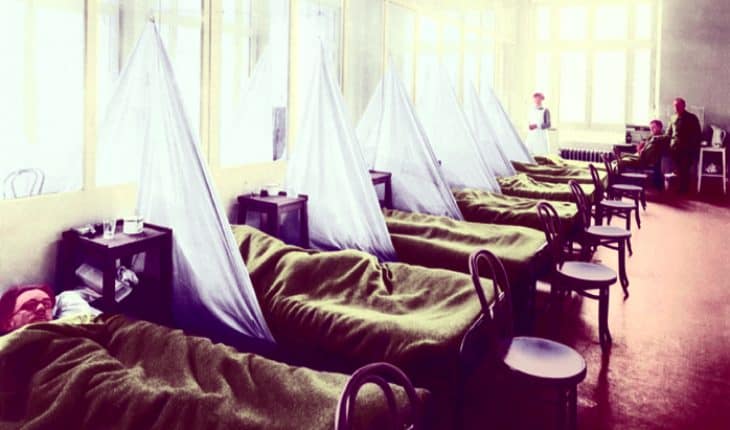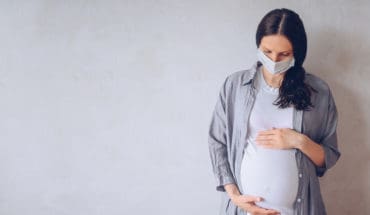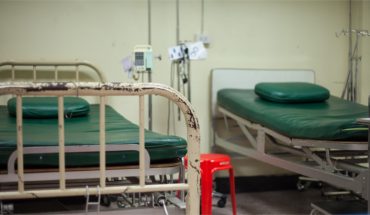A new exhibition opening at the Florence Nightingale Museum, in the basement of St Thomas’s Hospital, London, on 21st September explores nursing during history’s deadliest flu pandemic in 1918.
Building on Florence Nightingale’s work during the Crimean war, World War I ushered in a new era for military nursing. Women from all walks of life were filled with a desire to serve their country. But in 1918, as World War I approached its end, nothing could have prepared them for what was to come – the deadly Spanish Flu. Massive troop activities and a population weakened by hunger and war helped spread the disease. There was no cure for Spanish Flu, and doctors struggled to treat it. Good nursing was the only thing that helped and it was typically women that bore the brunt of trying to halt this deadly killer.
Infecting up to half the world’s population, the lethal flu pandemic occurred during World War I and the death toll far outstripped that of the war, with victims suffering from often terrifiying and gruesome symptoms.
Infecting up to half the world’s population, the lethal flu pandemic occurred during World War I and the death toll far outstripped that of the war, with victims suffering from often terrifiying and gruesome symptoms.
Investigations, in 1999, by a team of virologist at St Barthololemew’s Hospital and the Royal Hospital, led by Professor John Oxford, the world’s leading flu expert, identified the major troop staging and hospital camp in France, as being the centre of the Spanish flu.
A decade ago, on 16th September 2008, the body of distinguished British politician and diplomat Sir Mark Sykes, who had died from Spanish flu, was exhumed, after his living relatives gave permission in the interests of science, in order to reach a better understanding of the genetic structure of modern H5N1 bird flu virus. Sykes had been buried in a lead coffin, in 1919, which scientists hoped had helped preserve the virus. Sadly when they exhumed the coffin they discovered it had cracked under the weight of the soil above it and Sykes’s body was badly decomposed. The scientists, led by Professor Oxford. managed to take samples of his brain and lung tissue to be used for research in the quest to develop defences against future flu pandemics.
Usually flu hits the very young, and the very old, more than healthy young people, but the 1918 flu killed many thousands of healthy young adults, possibly because younger people had a more extreme immunological response to the virus. The pandemic was caused by a type of Avian Influenza which is still a danger today, is sometimes called ‘The Spanish Flu’ not because it originated in Spain but because that nation had remained neutral during the war and freely reported news of flu activity. It was estimated that around 500 million people, around one third of the world’s population became infected with this virus and the pandemic was so severe that from 1917-18 life expectancy fell by around 12 years, even in the relatively affluent United States.
It was estimated that around 500 million people, around one third of the world’s population became infected with this virus and the pandemic was so severe that from 1917-18 life expectancy fell by around 12 years, even in the relatively affluent United States.
In the 1930s medical students doing studies on pathology in Birmingham were shown a number of specimens preserved in large glass jars of formaldehyde. These included lungs of victims of the Spanish flu which were a strikingly vivid shade of bright pink, revealing how extensive the damage had been.
Visitors to the exhibition can Journey back in time to a field hospital in 1918 and explore the experiences of those that lived and died during the deadliest pandemic in human history, and discover if a similarly devastating pandemic could happen again today.
Nurses played an important role in World War II thanks in part to Florence Nightingale’s legacy. One of our greatest Victorians and a female icon in her own, lifetime, Nightingale was the founder of modern nursing. On returning from the battlefields of Scutari she opened the Nightingale Nursing School in St Thomas’s and the Florence Nightingale Museum is located on the original site of the school. Displays of period mementoes, clothing, furniture, books, letters and portraits – including her stuffed pet owl, Athena.
Visitors to the museum can the actual lamp she carried which earned her the nickname ‘Lady with the Lamp,’ see her pet owl and medicine chest.Most artefacts in the Museum’s collection were gathered by Dame Alicia Lloyd-Still during her time as Matron of St Thomas’s Hospital (1913-1937). Her collection was then held by the Nightingale Training School at St Thomas where it was known as the ‘Nightingalia’
Florence Nightingale’s extraordinary achievement continues to inspires new generations of nurses around the world.
Spanish Flu at the Florence Nightingale Museum 21 September 2018 to 16 June 2019
Florence Nightingale Museum, St Thomas’s Hospital, 2 Lambeth Palace Road, London SE1 7EW
Admission to the exhibition is free with paid museum admission
- People’s Choice Victory for Down’s Syndrome Scotland Garden at Chelsea 2025 - 28th May 2025
- Cadogan: A Chelsea Family By Tamsin Perrett - 3rd May 2025
- Dream Worlds a new exhibition in Cambridge - 14th December 2024







And there is a case to be made that many more died in the Pandemic because conventional or allopathic doctors, fed people Aspirin.
The Homeopathic hospitals performed vastly better in terms of treating Flu patients. Odd how such things are so quickly forgotten.